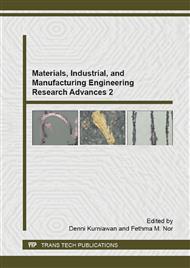p.186
p.190
p.195
p.200
p.205
p.210
p.217
p.222
p.227
The Effectiveness of Cationic and Polymer Inhibitors on Shale
Abstract:
Maintaining the borehole stability while drilling oil and gas wells is a major problem when drilling through water sensitive formation. Drilling using oil-based drilling fluid is the most effective solution to control shale. Due to the increasing environmental constraints on the use of mineral oil-based drilling fluid system, expensive research has been studied to optimize oil well operations and minimize drilling cost using new water-based drilling fluid system. In this study, the effectiveness of three commonly used shale inhibitors were tested, where cationic polymer and KLA-Gard are cationic type inhibitors and PHPA is polymer type inhibitor. Two types of shale samples were used in this study, both were taken from Malaysia. Each shale sample represents different degree in swelling and dispersion characteristic. The testing procedures were employed for the shale reactivity evaluation, inhibitors’ performance evaluation, rheology and filtration loss effect evaluation as well as the character of the recovered shale from dispersion test. Result showed that the cationic type inhibitor is suitable to be used for swelling shale. For disperse shale, polymer type inhibitor is the best selection to be added in the drilling fluid system. The combination of cationic inhibitor used along with the polymer inhibitor showed reduction in dispersion and swelling tendency. It is also found that the cationic inhibitors showed well compatibility with other polymers in the ionic solution. Cationic inhibitors do not affect the rheology and filtration loss properties but polymer inhibitors affect these properties.
Info:
Periodical:
Pages:
205-209
Citation:
Online since:
October 2015
Authors:
Keywords:
Price:
Сopyright:
© 2015 Trans Tech Publications Ltd. All Rights Reserved
Share:
Citation:


